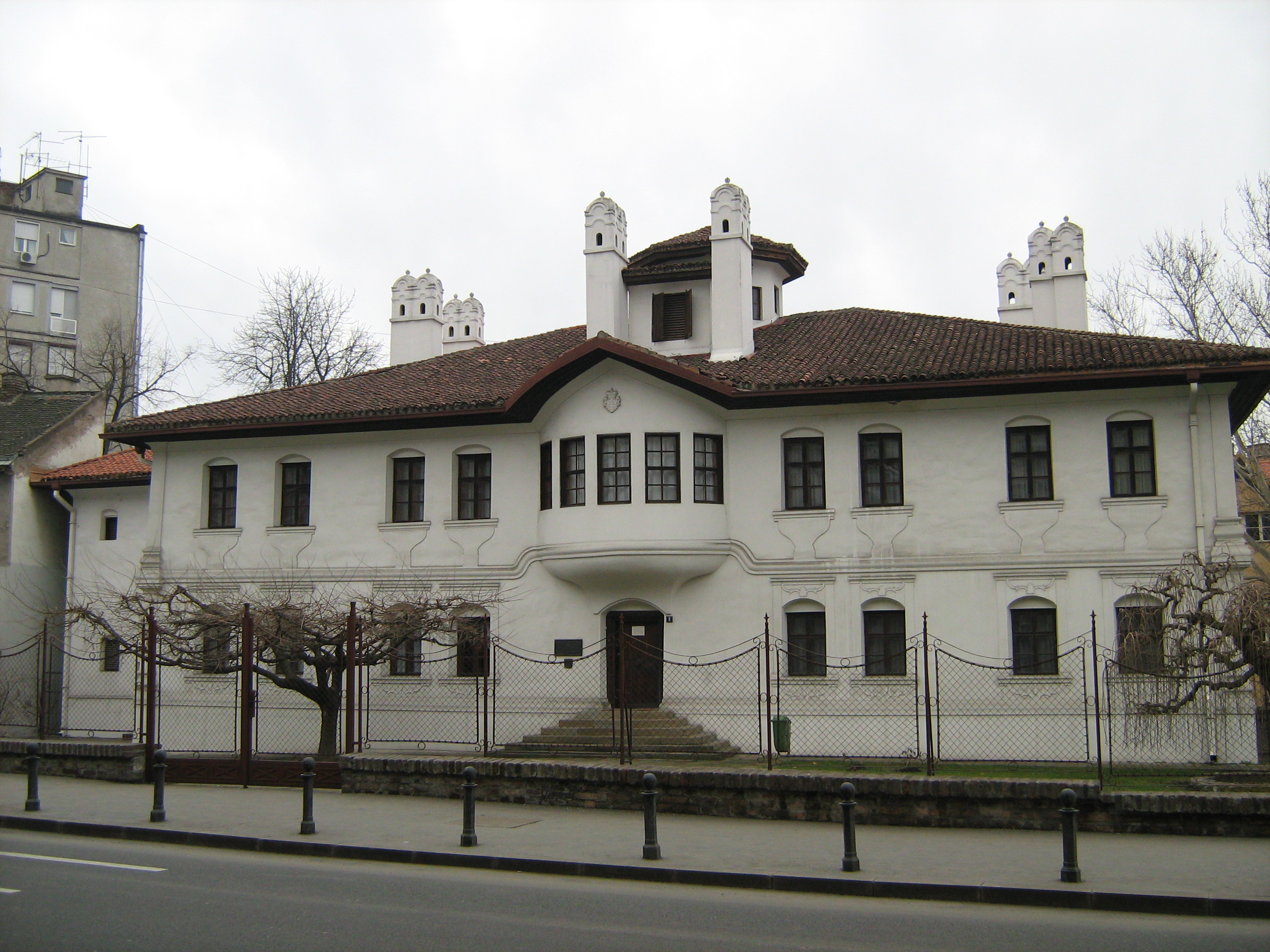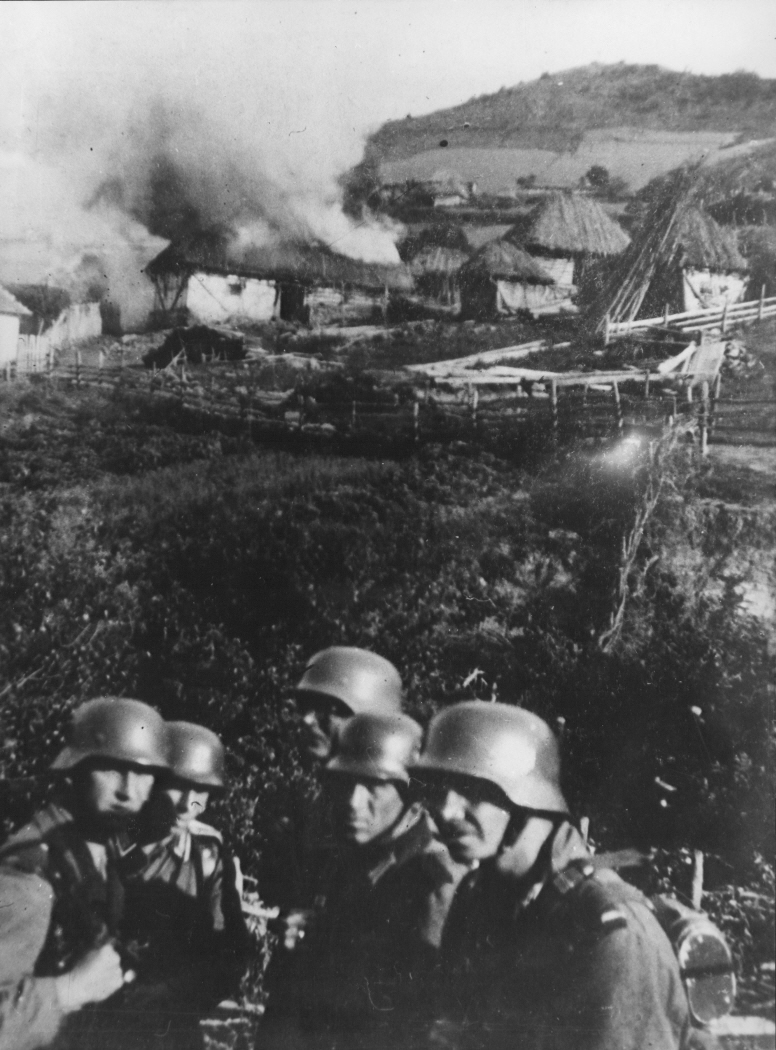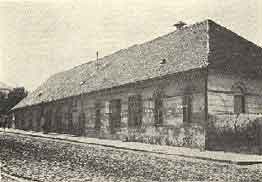|
Church Of The Virgin Hodegetria, Mušutište
The Church of the Virgin Hodegetria (; ) was a 14th-century Serbian Orthodox church in Mušutište, near Suva Reka, Kosovo,. The church was destroyed by Kosovar Albanian forces during the destruction of the Serbian part of Mušutište, after the end of the Kosovo war in 1999. History The church was built as an endowment by Serbian nobleman Jovan Dragoslav in 1315. The inscription at the entrance of the church was considered one of the oldest and most accomplished Serbian epigraphic texts of its kind. It was an inscribed-cross church with a semi-dome and a semi-round apse. The wall was built of alternating rows of bricks and stone cubes. The frescoes of the Mušutište School, related to the style of the Palaiologos era, were painted between 1316 and 1320 and were famed for their plasticity and the saints' typology were known as the best examples of Serbian art. In the altar area there was a unique portrait of St Clement of Ohrid. In the north-western corner of the naos there w ... [...More Info...] [...Related Items...] OR: [Wikipedia] [Google] [Baidu] |
Mušutište
Mushtisht or Mušutište ( sr-Cyrl, Мушутиште) is a village in the Suhareka municipality in Kosovo. It is located to the west of the Nerodimka mountain. It has 10 medieval Serbian Orthodox churches, including the notable Church of Virgin Hodegetria, which was destroyed in 1999. The village used to have a mixed Albanian-Serbian population; according to the 1991 census, it had 5016 inhabitants. The Serbian inhabitants fled the village during the Kosovo war. All their houses were subsequently set on fire and most of their properties usurped. Their return to the village has been actively opposed by an Albanian group. History It was first mentioned in a Serbian charter dating to 1315. In a charter of Emperor Stephen Uroš IV Dušan, dating to 1348, Mušutište, along with the churches of Virgin Hodegetria and St. Symeon (Sv. Simeona), were granted (''metochion'') to the Saint Archangels Monastery in Prizren. The churches were destroyed in the 1999 conflict. Notable pe ... [...More Info...] [...Related Items...] OR: [Wikipedia] [Google] [Baidu] |
Theodore Stratelates
Theodore Stratelates (, ; ), also known as Theodore of Heraclea (; AD 281–319), was a martyr and warrior saint in the Eastern Orthodox, Catholic and Oriental Orthodox Churches. There is much confusion as to whether he and St. Theodore of Amasea were the same person, as the stories about their lives later diverged into two separate traditions. Life Of Greek origin, Theodore was born in the city of Euchaita in Asia Minor. He killed a giant serpent living on a precipice in the outskirts of Euchaita. The serpent had terrorised the countryside. Theodore armed himself with a sword and vanquished it. According to some of the legends, because of his bravery, Theodore was appointed military-commander (''stratelates'') in the city of Heraclea Pontica, during the time the emperor Licinius (307–324) began a fierce persecution of Christians. Theodore invited Licinius to Heraclea, having promised to offer a sacrifice to the pagan gods. He requested that all the gold and silver statu ... [...More Info...] [...Related Items...] OR: [Wikipedia] [Google] [Baidu] |
Medieval Serbian Sites In Kosovo
In the history of Europe, the Middle Ages or medieval period lasted approximately from the 5th to the late 15th centuries, similarly to the post-classical period of World history (field), global history. It began with the fall of the Western Roman Empire and transitioned into the Renaissance and the Age of Discovery. The Middle Ages is the middle period of the three traditional divisions of Western history: classical antiquity, the medieval period, and the modern period. The medieval period is itself subdivided into the Early Middle Ages, Early, High Middle Ages, High, and Late Middle Ages. Population decline, counterurbanisation, the collapse of centralised authority, invasions, and mass migrations of tribes, which had begun in late antiquity, continued into the Early Middle Ages. The large-scale movements of the Migration Period, including various Germanic peoples, formed new kingdoms in what remained of the Western Roman Empire. In the 7th century, North Africa and the ... [...More Info...] [...Related Items...] OR: [Wikipedia] [Google] [Baidu] |
Destroyed Churches In Kosovo
*
{{disambiguation ...
Destroyed may refer to: * ''Destroyed'' (Sloppy Seconds album), a 1989 album by Sloppy Seconds * ''Destroyed'' (Moby album), a 2011 album by Moby See also * Destruction (other) * Ruined (other) Ruins are the remains of man-made architecture. Ruins or ruin may refer to: History *The Ruin (Ukrainian history), a period in Ukrainian history after the death of Bohdan Khmelnytsky in 1657 Geography *Ruin, Iran, a village in North Khorasan Pr ... [...More Info...] [...Related Items...] OR: [Wikipedia] [Google] [Baidu] |
14th-century Serbian Orthodox Church Buildings
The 14th century lasted from 1 January 1301 (represented by the Roman numerals MCCCI) to 31 December 1400 (MCD). It is estimated that the century witnessed the death of more than 45 million lives from political and natural disasters in both Europe and the Mongol Empire. West Africa experienced economic growth and prosperity. In History of Europe, Europe, the Black Death claimed 25 million lives wiping out one third of the European population while the Kingdom of England and the Kingdom of France fought in the protracted Hundred Years' War after the death of King Charles IV of France led to a claim to the French throne by King Edward III of England. This period is considered the height of chivalry and marks the beginning of strong separate identities for both England and France as well as the foundation of the Italian Renaissance and the Ottoman Empire. In History of Asia, Asia, Tamerlane (Timur), established the Timurid Empire, history's third largest empire to have been ever ... [...More Info...] [...Related Items...] OR: [Wikipedia] [Google] [Baidu] |
Cultural Monuments Of Exceptional Importance (Serbia)
Immovable Cultural Heritage of Exceptional Importance (/) are those objects of Immovable Cultural Heritage of Serbia, cultural heritage that enjoy the highest level of state protection in the Republic of Serbia. Immovable Cultural Heritage is classified as being of Exceptional Importance upon decision by the National Assembly of Serbia. They are inscribed in the ''Central Register of Immovable cultural property'' maintained by the . Objects of Immovable cultural heritage have to fulfill one or more of those criteria defined in the ''Law on Cultural Heritage'' of 1994 in order to be categorized as being "of exceptional importance": # exceptional importance for social, historical or cultural development of the people, or for the development of its natural environment; # evidence of important historic events or persons and their work; # unique (rare) example of human creativity of the time or a unique example from the natural history; # great influence on the development of society, cul ... [...More Info...] [...Related Items...] OR: [Wikipedia] [Google] [Baidu] |
Serbs In Kosovo
Kosovo Serbs form the largest ethnic minority group in Kosovo (5–6%). The precise number of Kosovo Serbs is difficult to determine as they have boycotted national censuses. However, it is estimated that there are about 95,000 of them, nearly half of whom live in North Kosovo. Other Serbian enclaves in Kosovo, Kosovo Serb communities live in the Southern municipalities of Kosovo. The medieval Kingdom of Serbia (medieval), Kingdom of Serbia (1217–1346) and the Serbian Empire (1346–1371) included parts of the territory of Kosovo until its annexation by the Ottomans following the Battle of Kosovo (1389), considered one of the most notable events of Serbian history. Afterwards, it was a part of the Serbian Despotate. Modern Serbian historiography considers Kosovo in this period to be the political, religious and cultural core of the Medieval Serbia, medieval Serbian state. In the History of the Balkans#Late Middle Ages, Ottoman period (1455–1913), the situation of the Serb p ... [...More Info...] [...Related Items...] OR: [Wikipedia] [Google] [Baidu] |
Assembly Of Serbia
The National Assembly ( sr-Cyrl-Latn, Народна скупштина, Narodna skupština, ), fully the National Assembly of the Republic of Serbia (), is the Unicameralism, unicameral legislature of Serbia. The assembly is composed of 250 Deputy (legislator), deputies who are Proportional representation, proportionally elected to four-year terms by secret ballot. The assembly elects a President of the National Assembly of Serbia, president (speaker) who presides over the sessions.wikisource:Constitution of Serbia#1. National Assembly, Wikisource: Constitution of Serbia The National Assembly exercises supreme legislative power. It adopts and amends the Constitution of Serbia, Constitution, elects Government of Serbia, Government, appoints the Governor of the National Bank of Serbia and other state officials. All decisions are made by majority vote of deputies at the session at which a majority of deputies are present, except for amending the Constitution, when a two-thirds maj ... [...More Info...] [...Related Items...] OR: [Wikipedia] [Google] [Baidu] |
Monuments Of Culture Of Exceptional Importance (Serbia)
A monument is a type of structure that was explicitly created to commemorate a person or event, or which has become relevant to a social group as a part of their remembrance of historic times or cultural heritage, due to its artistic, historical, political, technical or architectural importance. Examples of monuments include statues, (war) memorials, historical buildings, archaeological sites, and cultural assets. If there is a public interest in its preservation, a monument can for example be listed as a UNESCO World Heritage Site. The '' Palgrave Encyclopedia of Cultural Heritage and Conflict'' gives the next definition of monument:Monuments result from social practices of construction or conservation of material artifacts through which the ideology of their promoters is manifested. The concept of the modern monument emerged with the development of capital and the nation-state in the fifteenth century when the ruling classes began to build and conserve what were termed monument ... [...More Info...] [...Related Items...] OR: [Wikipedia] [Google] [Baidu] |
Holy Virgin
Mary was a first-century Jewish woman of Nazareth, the wife of Joseph and the mother of Jesus. She is an important figure of Christianity, venerated under various titles such as virgin or queen, many of them mentioned in the Litany of Loreto. The Eastern and Oriental Orthodox, Catholic, Anglican, Methodist, Reformed, Baptist, and Lutheran churches believe that Mary, as mother of Jesus, is the Mother of God. The Church of the East historically regarded her as Christotokos, a term still used in Assyrian Church of the East liturgy. Other Protestant views on Mary vary, with some holding her to have lesser status. She has the highest position in Islam among all women and is mentioned numerous times in the Quran, including in a chapter named after her.Jestice, Phyllis G. ''Holy people of the world: a cross-cultural encyclopedia, Volume 3''. 2004, , p558 Sayyidana Maryam . She is also revered in the Baháʼí Faith and the Druze Faith. The synoptic Gospels name Mary as th ... [...More Info...] [...Related Items...] OR: [Wikipedia] [Google] [Baidu] |
Christ
Jesus ( AD 30 or 33), also referred to as Jesus Christ, Jesus of Nazareth, and many other names and titles, was a 1st-century Jewish preacher and religious leader. He is the Jesus in Christianity, central figure of Christianity, the Major religious groups, world's largest religion. Most Christians consider Jesus to be the Incarnation (Christianity), incarnation of God the Son and awaited Messiah#Christianity, messiah, or Christ (title), Christ, a descendant from the Davidic line that is prophesied in the Old Testament. Virtually all modern scholars of classical antiquity, antiquity agree that Historicity of Jesus, Jesus existed historically. Accounts of Life of Jesus, Jesus's life are contained in the Gospels, especially the four canonical Gospels in the New Testament. Since the Age of Enlightenment, Enlightenment, Quest for the historical Jesus, academic research has yielded various views on the historical reliability of the Gospels and how closely they reflect the hi ... [...More Info...] [...Related Items...] OR: [Wikipedia] [Google] [Baidu] |
Saint Pantaleon
Saint Pantaleon (), counted in Western Christianity as among the Fourteen Holy Helpers of the Late Middle Ages, and in Eastern Christianity as one of the Holy Unmercenary Healers, was a martyr of Nicomedia in Bithynia during the Diocletianic Persecution of 305 AD. Though there is evidence to suggest that a martyr named Pantaleon existed, some consider the stories of his life and death to be purely legendary. Life of Pantaleon According to the martyrologies, Pantaleon was the son of a rich pagan, Eustorgius of Nicomedia, and had been instructed in Christianity by his Christian mother, Saint Eubula; however, after her death he fell away from the Christian church, while he studied medicine with a renowned physician Euphrosinos; under the patronage of Euphrosinos he became physician to the emperor, Maximian (or alternatively Galerius). He was won back to Christianity by Saint Hermolaus (characterized as a bishop of the church at Nicomedia in the later literature), who convinced ... [...More Info...] [...Related Items...] OR: [Wikipedia] [Google] [Baidu] |






